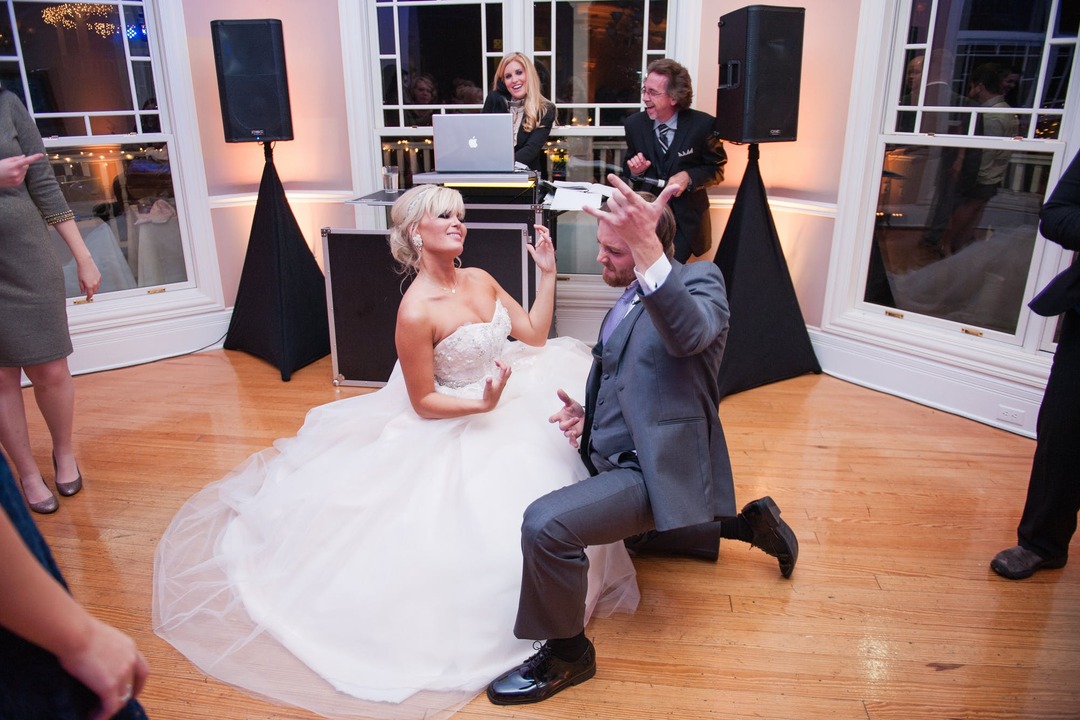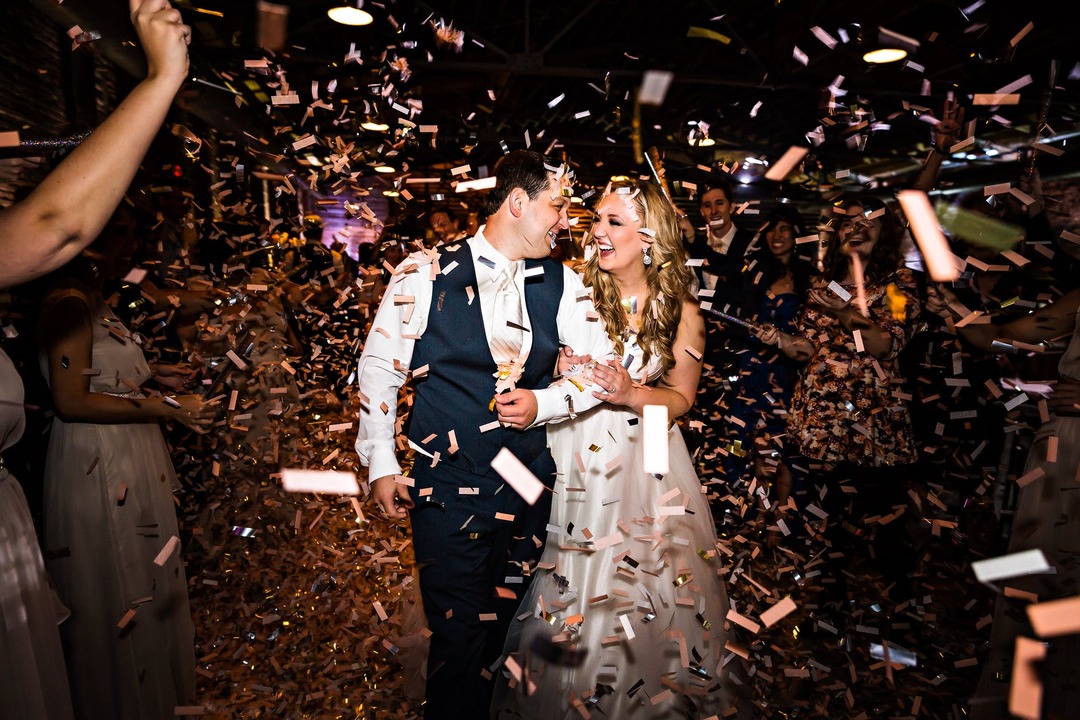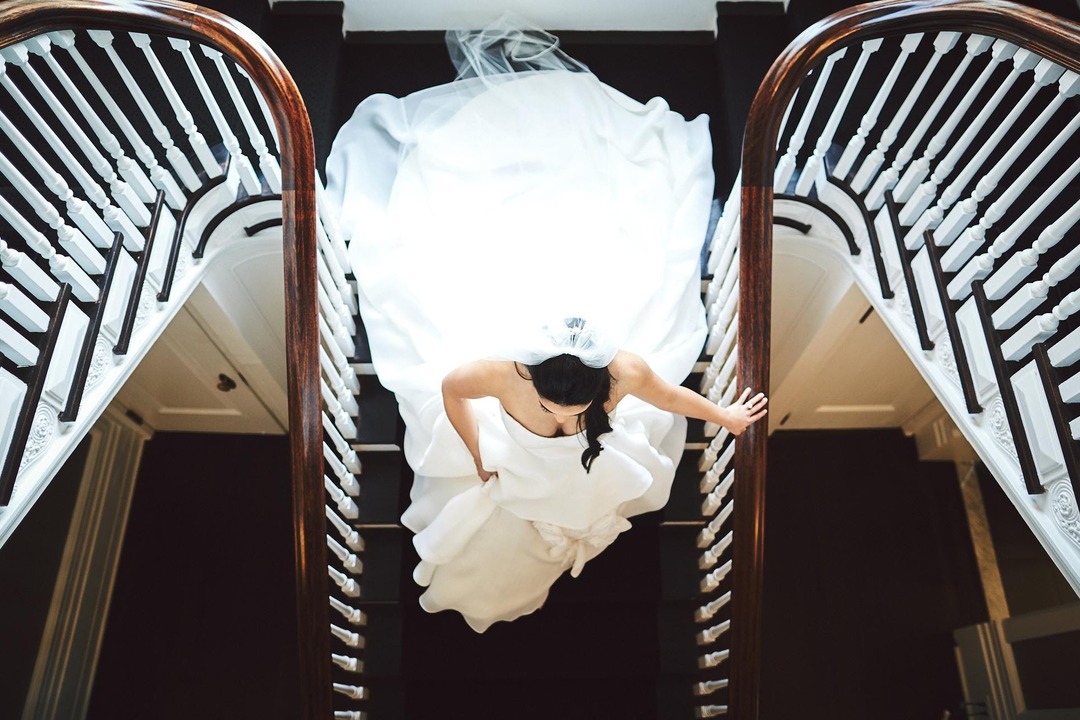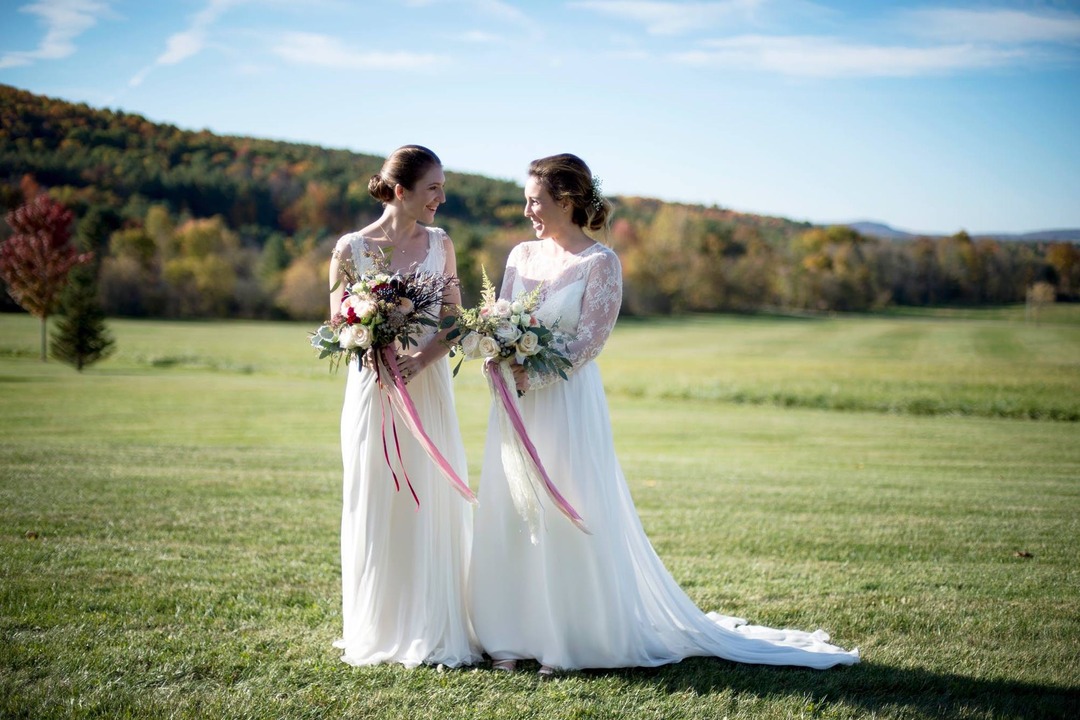- Expert advice/
- Fashion & beauty/
- Wedding dresses/
- How to Dance in a Wedding Dress + 11 Wedding Dress Options
- Wedding dresses
How to Dance in a Wedding Dress + 11 Wedding Dress Options
You don’t have to sacrifice your dance moves for your dream dress. We’ll show you how to dance in a wedding dress with a train, so you can party all night long.
Last updated February 5, 2024

Whether you have yet to go wedding dress shopping or have already decided on your dream dress, you don’t want to overlook this one thing in the wedding planning process: the train.
The train of your wedding dress can impact everything from how easy it is to walk down the aisle to how low you can get on the dance floor. But if your heart is set on a bridal dress with a long train, you don’t have to sacrifice your dance moves for your dream dress or vice versa—you just need to prepare a little.
If you’ll be donning a heavy wedding dress train, we’ll show you what steps you need to take to ensure you can dance the night away in your perfect dress.

How to Dance in a Wedding Dress With a Train
1. Alter Your Dress
Before you click away, let us explain. We’re not saying the way to dance with a train is to alter it away. However, there are a few simple alterations your seamstress can make that will make it easier to dance in your wedding dress when the time comes.
2. Shorten the Train
If you fell in love with a dress that has an extravagant train, you don’t have to commit to its length. Your alterations expert can often easily shorten the train on your wedding gown to be more manageable (read: danceable). Take it to a seamstress who knows what she’s doing and find a train length you’re comfortable moving around in.
3. Add a Bustle
A bustle is the best way to alter your dress to be reception-ready without taking away from the integrity of it. Bustles come in all shapes and sizes, but are usually made up of a series of loops and buttons that connect.
Post-ceremony, your maid of honor, or another of your bridesmaids, will typically be the one to help you connect the dots. Once bustled, your train will cascade down the back of your bridal dress, or be tucked neatly underneath it in a secure fashion that frees up your feet. And don’t worry: A talented seamstress with experience bustling wedding dresses will disguise the buttons and loops in the seams and beading of the wedding gown, so they’re hardly noticeable.
If you don’t want to bustle your dress, either because you don’t like the way it looks or because you don’t want to pay for the alterations, you can also add a simple loop to the end of the bridal train. You can wear the loop on your wrist to carry your train with you around the venue and on the dance floor. This style works best for dresses with short, lightweight trains, since you will, in fact, be carrying it all night.
4. Make the Train Detachable
Praise the wedding dress designers who first decided on detachable trains. If you opt for an attachable skirt, a Watteau, a bridal cape, or the like, you can remove the extra fabric completely post-ceremony and pre-reception. A detachable wedding train not only makes the dress easier to dance in, but also creates a whole new look. It’s as if you got a super-fashionable BOGO deal on your dream dress.
Know What Your Dress Can Do
Not all wedding dresses are created equal—and some are more difficult to dance and twirl in than others. Know what your dress can do before you attempt to bust a move, so you don’t break more than the dance floor.
Select the Right Silhouette
The silhouette impacts your ability to dance the most. For example, a mermaid gown will restrict the size of movements you can make, specifically with your feet and legs, while an off-the-shoulder neckline will restrict how much you can move your arms.
If you love to dance, pay special attention to how your bridal gown will affect your moves. The dress’s silhouette, sleeves (or lack thereof), and the train length will influence your ability to dance the most. If you are planning a choreographed first dance, be sure to tell your choreographer if there are any movements you won’t be able to master based on the style and fit of your dress.
Practice
While you won’t be able to run a dress rehearsal of your first dance, unless you buck tradition and are willing to let your fiancé see you in your dress before the big day, you can still practice in it. When you’re at your final fittings, attempt any choreography you plan on doing on the day of (to the best of your ability) to ensure your dress can handle the moves. It’s better to risk popping a seam or letting a button fly when your seamstress is right there to fix it than it is on your wedding day. And if you're taking wedding dance lessons, consider wearing a dress in a similar silhouette and length to your next lesson to get a real feel for how things will move on your wedding day.
It’s also important that the hemline is short enough, so you won’t be tripping over your dress on the dance floor. Take steps forward, side to side, and backward while at your fitting, both with and without a bustle, to make sure you can not only dance, but also get around in your gown. If you can’t walk with ease, have your seamstress raise the hemline up a bit.
Practicing the first dance isn’t only important before the big day. If you can, sneak away during cocktail hour, once you and your partner have already seen each other (and are married!), to practice one last time before you dance to your favorite wedding songs. Ditch any moves that could potentially damage the dress and remind your spouse not to step on it.
Change Your Dress
Dancing in a wedding dress can be difficult, which is a very valid excuse for an outfit change. You wouldn’t be the first bride to swap her beaded heels for Chuck Taylor’s or her ball gown for a mini dress, and you definitely won’t be the last.
Opt for a Second Reception Dress
If you’ve already fallen in love with a wedding dress that will be unforgiving when you want to walk, sit, and dance at the wedding reception, consider changing into a second dress. If the budget allows, a second dress can be your saving grace. It not only gives you the freedom to dance the night away, but also allows you to preserve the train on your original dress.
Plus, you can showcase your bridal style in more ways than one. Change into a slinky slip dress or show off your shoes in a fun fringed mini. Whatever you choose, it should be comfortable and easy to move in.

...And Change Your Shoes
You will be especially prone to stepping on your dress when taking quick or big steps during your wedding dance, and depending on the style shoes you’re wearing, you could damage your dress. Heels can easily get caught in a lacy bridal train or layers of tulle. Say goodbye to your precious pumps in favor of wedges, platform heels, or even sneakers. That’s right—if you’re wearing a long bridal gown, no one will see your feet anyway.
If you’re attached to your heels and don’t want to slip on some flat shoes for the reception, be extra careful and consider donning a petticoat underneath your dress. A petticoat can protect the inner layers of your gown from holes or snags that can happen when dancing.
And you thought you couldn’t learn how to dance in a wedding dress with a train? With a little practice, the right alterations, and a backup dress (or shoes), you’ll be swinging and swaying in style well into the night.
11 Wedding Dresses You Can Dance In
Ready to start shopping? Check out these wedding dresses you can dance in, including ball gowns, A-line styles, and even convertible dresses.
1. A-Line Dress
A-line is one of the best wedding dress styles for dancing—not to mention one of the most flattering dress silhouettes out there! You'll get a dramatic effect when you spin and twirl, and your partner won't be kept away by an overly large skirt.
Jenny Yoo Tamson Satin Plunge A-Line Wedding Gown, Anthropologie, $1495
2. Ball Gown Wedding Dress
Similarly to an A-line dress, a ball gown will give you plenty of room to move on the dance floor, as you won't be restricted by a form-fitting silhouette. Choose a ball gown with a skirt that has a lot of layers and some fluidity, so your partner can get nice and close for any dramatic wedding dance moves.
Watters Calia V-Neck Ball-Skirt Wedding Gown, Anthropologie, $2818
3. Convertible Wedding Dress
Want the best of both worlds? Shop for a wedding dress that has removable pieces. Whether it's a removable skirt, train, or sleeves, you can ditch any bulky layers and switch up your look before hitting the reception and tearing it up on the dance floor.
Oleg Cassini Removable Train Mermaid Wedding Dress, Anthropologie, $1124.25
4. Sleeveless Wedding Dress
When it comes to dance floor-ready dresses, you have to consider more than just the train, bustle, and skirt; you’ll also want to think about sleeves. If you're wearing a dress with fitted sleeves, or an off-the-shoulder wedding dress style, your movement might be more restricted than with a sleeveless option—so if freedom to dance is at the top of your priority list, a sleeveless wedding dress might be the cut for you.
Galvan Praiano Mixed Media Slip Dress, Bloomingdale's, $1995
5. Strapless Wedding Dress
A strapless neckline isn't for every bride, but if you love to throw your hands in the air, eliminating sleeves completely will give you total freedom of movement. Just make sure the dress stays in place when you do some trial dance moves at your dress fitting!
Watson Strapless Dress, Jenny Yoo, $1350
6. Tea-Length Wedding Dress
One of the most obvious options for having a wedding dress you can dance in is simply choosing a shorter length. Depending on the formality of your wedding, tea-length (or midi) dresses can be a great option to create the perfect bridal look without sacrificing any fun on the dance floor. Many tea-length wedding dresses have a nostalgic vibe, so they're great for brides who, in addition to dancing, love vintage style. They're also inherently more casual, so midi-length wedding dresses are ideal for low-key celebrations.
Sachin & Babi Sierra V-Neck Satin Midi Dress, Anthropologie, $250
7. High-Low Wedding Dress
Want to show off your shoes—and prevent tripping on the dance floor at the same time? A high-low option is a bit more formal than a tea-length wedding dress style, since it's longer in the back—but will still help keep your feet and ankles free of any fabric while you dance the night away.
ML Monique Lhuillier High-Low Gown, Nordstrom, $446.25
8. Side Slit Wedding Dress
In addition to adding a touch of sexiness to your wedding day look, a dress with a side slit (or even a back slit!) will give you extra mobility, which can help you move more easily on the dance floor—especially if you gravitate towards more fitted silhouettes.
Mac Duggal Embroidered Lace-Up Back Tulle Gown, Nordstrom, $898
9. Two-Piece Wedding Dress
A two-piece wedding dress will typically give you a more relaxed, casual look—and can also deliver more freedom of movement. A two-piece might not be a formal enough wedding dress style for your big day, but it's a great option for any bride who wants to do some serious dancing.
Janet Two-Piece Wedding Dress, Lula Bridal, $191
10. Chiffon Wedding Dress
A lighter-weight fabric will make for easier movement on the dance floor! So, if you’re looking for a dance-friendly fabric option, stay away from heavy beading, sequins, and thick fabrics, and instead, turn to something easy and breezy—like chiffon.
Tegan Chiffon Wedding Dress, Jenny Yoo, $1350
11. Couture Wedding Dress
If you're looking for something truly one-of-a-kind, a couture wedding dress could be just the thing. Couture wedding dresses are custom made for the wearer, so you would work with the designer to create a dress that fits all of your needs and preferences—including dance-ability!
Up next for you

Best Wedding Dresses for Tall Brides
Inspiration
Find out which silhouettes work best for wedding dresses for tall brides, and get a few styling tips as you prepare for your big day.

What Are the Different Types of Wedding Dress Trains?
Inspiration
Just like weddings and the couples who plan them, wedding dress train types come in all different styles. We’ll help you find the right one for you.

Guide to Wedding Dress Lengths
How-To
From mini to monarch, this guide will help you learn about every wedding dress length and which one is right for you.

Best Wedding Dress Styles for Petite Women
Inspiration
Create height and lengthen your torso by learning about the best wedding dress styles for short women.
- Expert advice/
- Fashion & beauty/
- Wedding dresses/
- How to Dance in a Wedding Dress + 11 Wedding Dress Options
Find even more wedding ideas, inspo, tips, and tricks
We’ve got wedding planning advice on everything from save the dates to wedding cakes.
